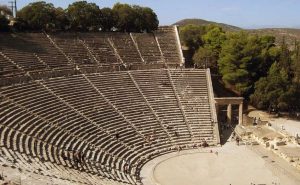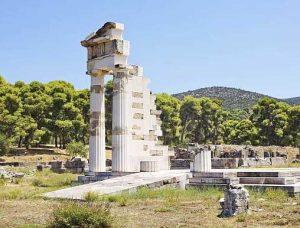Ancient Theater of Epidaurus Greece

The theater of Epidaurus is built on the slope of Mount Kynorti, near Lygourio of Argolis, in the Municipality of Asklipieiou.
The theater was built in two phases: the first phase dates to the end of the 4th century BC and the second to the middle of the 2nd century BC.
As it survives today, the theater presents the typical tripartite structure of Hellenistic theaters: hollow, orchestra and stage building.
During the first phase, at the end of the 4th century BC, the orchestra, the lower stage – 12 bleachers with 34 rows of seats each – and the stage building were built. The design of the hollow was carried out with the help of three engraving centers.
In the second phase, in the middle of the 2nd century BC, the hollow was extended upwards with the construction of the upper diazom (22 stands with 21 rows of pews each) and the stage took on its Hellenistic form.
With a maximum capacity of 13,000 to 14,000 spectators, the theater of Epidaurus hosted musical competitions and performances of ancient drama.
The aesthetic harmony due to the regularity and mathematical relevance of its individual sizes, combined with its excellent acoustics that allow listeners in the upper stands to hear even the tiniest sound from the orchestra.
The aesthetics and functionality of the theater had already been highlighted since antiquity. Pausanias singles out the theater of Epidaurus for its symmetry and beauty and attributes it to the architect Polykleitos.
The theater was kept in very good condition and with the restoration works of P. Kavadias (1907), A. Orlandos (1954-1963) and the Epidaurus Monuments Conservation Committee (1988 onwards) it has recovered – apart from the stage building – almost entirely in its original form.
The monument attracts a large number of Greek and foreign visitors and is used for the presentation of ancient drama performances. The first performance in the theater of Epidaurus was “Electra” by Sophocles, staged in 1938, directed by D. Rodiris.
Theatrical performances, as part of the organized festival, began in 1954 and from the following year were established as an annual institution for the presentation of ancient drama. Sporadically it has been used for important musical events.
The famous ancient theater which in the summer hosts performances of ancient drama in the context of the Athens and Epidaurus Festival is the main reason to come to the area. Built at the foot of the pine-covered mountain Akros at the mouth of a bay, the village of Palea Epidaurus is quite nice and is surrounded by an area overgrown with olives and citrus fruits.
The most beautiful place is its picturesque harbor, a classic stop for boats – the moored sailboats and boats compose the typical summer image of the settlement.
On the beach of Palea Epidaurus you will find rooms to let and hotels, many fish taverns, which open in summer and gather a lot of people, especially on festival nights. The route that connects New with Old Epidaurus is beautiful, with the asphalt road crossing a dense pine forest above the sea.
What to see
Asclepieion
 Leaving the theater and returning to the main cobbled path,you arive at the pre-eminent areas of the Asclepieion. After passing the ruins of the Guesthouse and the Roman Conservatory is the temple of Asclepius, which was built between 380 and 375 BC.
Leaving the theater and returning to the main cobbled path,you arive at the pre-eminent areas of the Asclepieion. After passing the ruins of the Guesthouse and the Roman Conservatory is the temple of Asclepius, which was built between 380 and 375 BC.
From the temple is preserved mainly the pillar (the floor). Behind the temple is the Dome, a circular structure that was the center of the mysterious cult of Asclepius. Finally, in direct relation to the above two monuments, is the Avaton (or cemetery), the long and narrow building in which the patients were treated.
Archaeological Museum
You will see many objects that the patients offered to the god as a sign of gratitude (the so-called votive offerings), as well as parts of architectural sculptures from the dozens of buildings in the area. The showcase with the ancient medical tools steals the impressions.
Castle of Piada
Piada was once called Old Epidaurus. Ruins of the castle are preserved today on a nearby hill.
Day trips
Ligurio
Inextricably linked to Epidaurus, the quiet town comes out of its “hibernation” every July and August and lives in the pulse of the festival, as it is flooded with lovers of ancient drama looking for a place in its taverns. Its main attraction is the magnificent Byzantine church of Agios Ioannis the Merciful (11th century), which dominates the square.
Didima
Leaving OldEpidavros and heading south, you will meet Tracheia after about 10 km – it is worth making a stop at its famous cheese dairies. Further south, following the dirt road to the village of Pelei looking for the Monastery of Avgou, which you will find literally rooted in a rock, in a location of wild natural beauty, at the entrance of the Radian gorge.
Continuing your way to the South, you will meet the Twin Caves. The second one is more interesting, which you can walk around to visit the chapels of Agios Georgios and the Transfiguration of the Savior, built opposite the walls of the cave.
Kranidi
Picturesque town in a privileged position, built on the hill of Agia Anna, south of Epidaurus. Take a walk in the alleys, where old stone houses coexist with tiled roofs and beautiful preserved neoclassical buildings and visit the monasteries of Panagia Pantanassa, Agia Anna and Agia Triada.
How to get to Epidaurus
For people coming without a car, there are a variety of bus options. Those that will be provided by KTEL Argolida depart from Athens on the days of the shows at 5 p.m. from the Kifissou intercity bus station (Kifissou 38 – former 100 – Postal code: 104 42).
The journey takes about two hours, while the return ticket costs €19.00. To buy tickets, you can visit the website (by clicking here) or call the Kifiss intercity bus station directly on the telephones: 801 11 44000 and 210 5134588 or (for Athens) at the office at 59 Sokratous Street – Omonia (tel. 210 5237889, 210 5233810, 210 5246805) or (for Piraeus) at 2 Astiggos Street and 4 Astiggos Street, in Karaiskaki Square, in front of gate 8 of the port (tel. 210 4125200, 210 4124800), but and in most tourist offices throughout Greece.
